AI In Cloud Computing Market Size 2025-2029
The ai in cloud computing market size is valued to increase by USD 27.43 billion, at a CAGR of 36.3% from 2024 to 2029. Proliferation of generative AI and large language models will drive the ai in cloud computing market.
Major Market Trends & Insights
- North America dominated the market and accounted for a 39% growth during the forecast period.
- By Component - Solutions segment was valued at USD 3.21 billion in 2023
- By Technology - Machine learning (ML) segment accounted for the largest market revenue share in 2023
Market Size & Forecast
- Market Opportunities: USD 644.03 million
- Market Future Opportunities: USD 27429.00 million
- CAGR from 2024 to 2029 : 36.3%
Market Summary
- The market is experiencing unprecedented growth, with businesses increasingly relying on artificial intelligence (AI) to enhance their cloud infrastructure. According to recent studies, The market is projected to reach a value of USD190.67 billion by 2025, reflecting a significant expansion from its current size. Key drivers for this growth include the proliferation of generative AI and large language models, which enable advanced capabilities such as natural language processing and machine learning. Furthermore, the rise of sovereign AI clouds and national AI factories is adding to the market's momentum, as governments and organizations seek to secure their data and maintain control over their AI applications.
- However, this growth comes with challenges. Data security, privacy, and governance complexities are becoming increasingly pressing concerns, as AI systems process and analyze vast amounts of sensitive information. To address these challenges, businesses must invest in robust security measures and implement strict data governance policies. Despite these challenges, the future of AI in cloud computing looks bright. As AI continues to evolve, it will offer new opportunities for businesses to streamline operations, improve customer experiences, and gain competitive advantages. By staying abreast of market trends and addressing the associated challenges, organizations can harness the power of AI in cloud computing to drive growth and innovation.
What will be the Size of the AI In Cloud Computing Market during the forecast period?
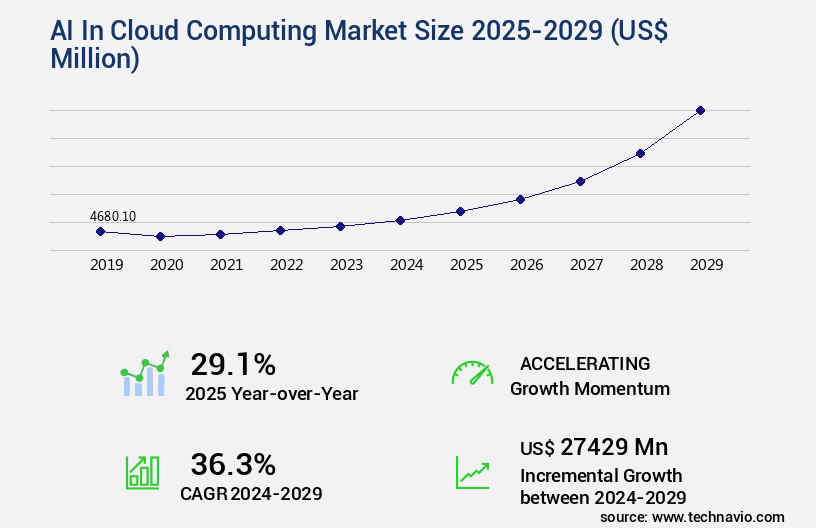
Get Key Insights on Market Forecast (PDF) Request Free Sample
How is the AI In Cloud Computing Market Segmented ?
The ai in cloud computing industry research report provides comprehensive data (region-wise segment analysis), with forecasts and estimates in "USD million" for the period 2025-2029, as well as historical data from 2019-2023 for the following segments.
- Component
- Technology
- Machine learning (ML)
- Deep learning
- Natural language processing (NLP)
- Others
- End-user
- BFSI
- IT and telecommunications
- Healthcare
- Retail and consumer goods
- Others
- Geography
- North America
- Europe
- APAC
- Australia
- China
- India
- Japan
- South Korea
- Rest of World (ROW)
By Component Insights
The solutions segment is estimated to witness significant growth during the forecast period.
The market continues to evolve, with the solutions segment serving as its technological backbone. This segment comprises the entire software, platforms, and infrastructure ecosystem that facilitates AI development, deployment, and management. It can be divided into three primary layers: Infrastructure as a Service (IaaS), Platform as a Service (PaaS), and Software as a Service (SaaS). IaaS offers access to high-performance computing resources, such as virtual machines outfitted with GPUs and Tensor Processing Units (TPUs), essential for demanding AI workloads. The PaaS layer is the most innovative, delivering managed platforms and APIs that abstract infrastructure complexities.
Additionally, the market is witnessing the emergence of cutting-edge technologies such as generative AI models, computer vision algorithms, natural language processing, and deep learning frameworks. Furthermore, AI-driven automation, cloud AI models, AI explainability techniques, AI bias mitigation, and federated learning platforms are gaining traction. Cloud infrastructure costs, automated machine learning, AI algorithm selection, and predictive maintenance models are also significant factors shaping the market landscape.
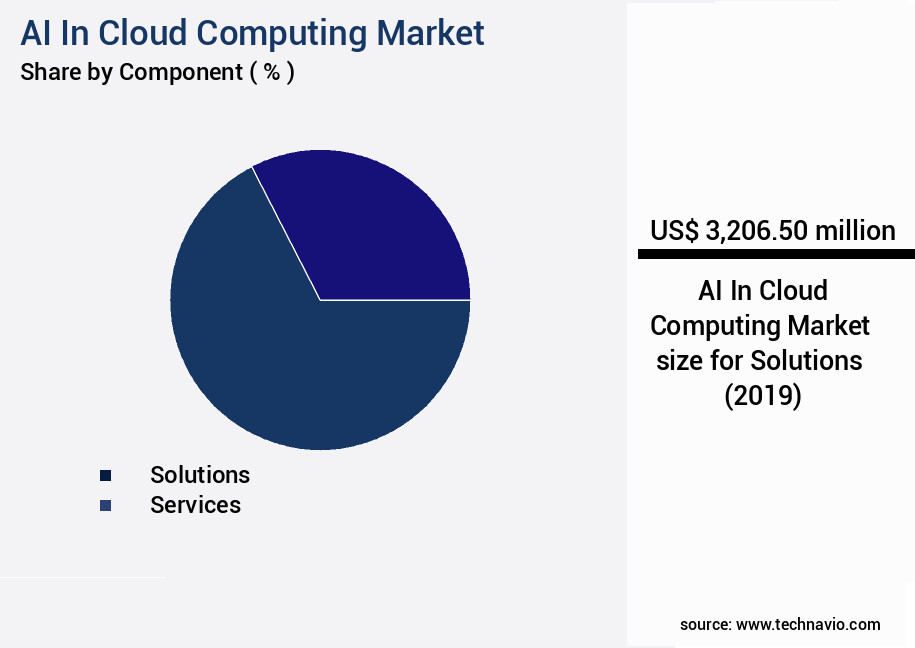
Request Free Sample
The Solutions segment was valued at USD 3.21 billion in 2019 and showed a gradual increase during the forecast period.
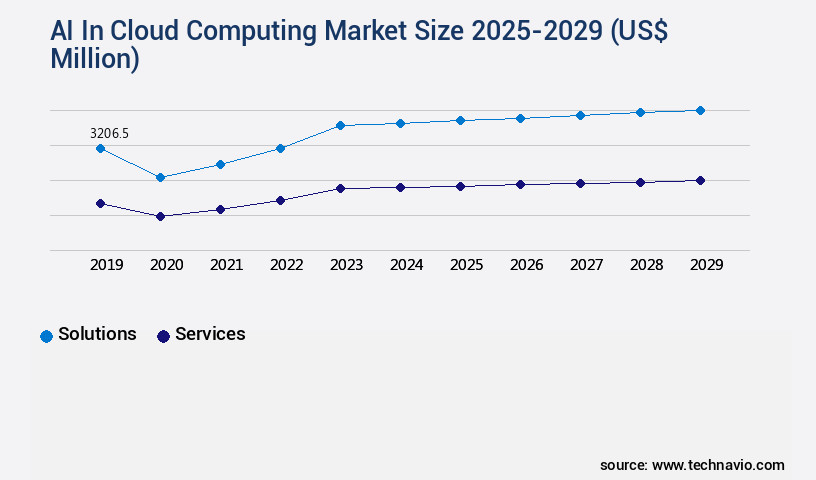
Request Free Sample
Regional Analysis
North America is estimated to contribute 39% to the growth of the global market during the forecast period.Technavio's analysts have elaborately explained the regional trends and drivers that shape the market during the forecast period.
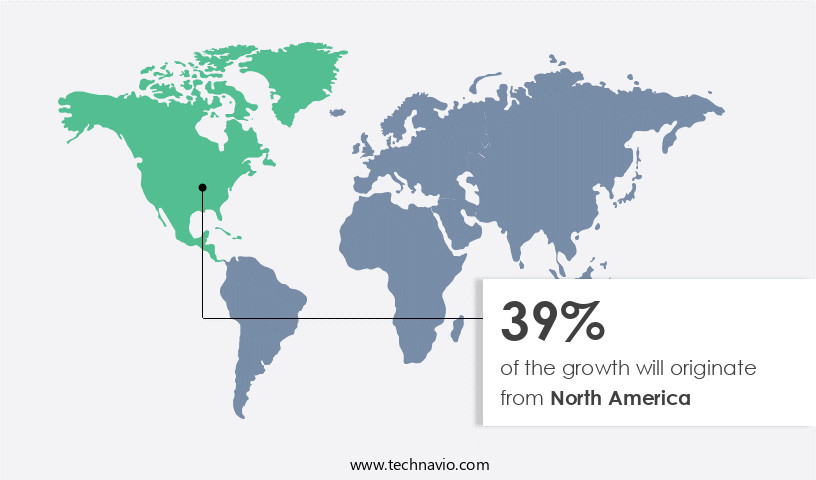
See How AI In Cloud Computing Market Demand is Rising in North America Request Free Sample
The market is witnessing significant growth, with North America leading the charge. This regional dominance is underpinned by the presence of major cloud providers, such as Amazon Web Services, Microsoft Azure, and Google Cloud Platform, and key hardware and AI research entities. The concentration of technological leadership in North America fosters a virtuous cycle of innovation, investment, and adoption. Enterprises in various sectors, including finance, healthcare, retail, and technology, are actively deploying advanced AI workloads in the cloud.
Market Dynamics
Our researchers analyzed the data with 2024 as the base year, along with the key drivers, trends, and challenges. A holistic analysis of drivers will help companies refine their marketing strategies to gain a competitive advantage.
The market is experiencing rapid growth as businesses seek to leverage the power of artificial intelligence (AI) for various applications. One key area of focus is GPU utilization for AI training, which allows for faster and more efficient processing of large datasets. Cloud service providers offer serverless functions for AI inference, enabling businesses to scale their AI workloads on demand and pay only for the resources they use. MLOps pipeline automation tools are essential for managing the entire AI development lifecycle, from data pipeline optimization techniques to AI model explainability methods. Cost-effective cloud AI infrastructure is crucial for businesses looking to implement AI at scale, while secure AI model deployment strategies ensure data security and compliance. Federated learning model training is another area of interest, enabling AI models to be trained on data from multiple devices or locations without the need for centralized data processing. Edge AI device management is also gaining traction, allowing businesses to process data locally on devices for real-time AI application development. Automated machine learning workflows and hyperparameter optimization algorithms help streamline the AI development process, while AI model versioning best practices ensure that businesses can manage and track multiple versions of their models. API integration for AI services and container orchestration for AI enable seamless integration with existing systems and efficient deployment of AI models. Data annotation quality control and AI bias detection and mitigation are important considerations for businesses implementing AI (artificial intelligence) , ensuring that their models are accurate and unbiased. Reinforcement learning model training and generative AI model applications offer exciting possibilities for businesses looking to push the boundaries of what AI can do. Overall, The market is poised for continued growth as businesses seek to harness the power of AI to drive innovation and improve operational efficiency.
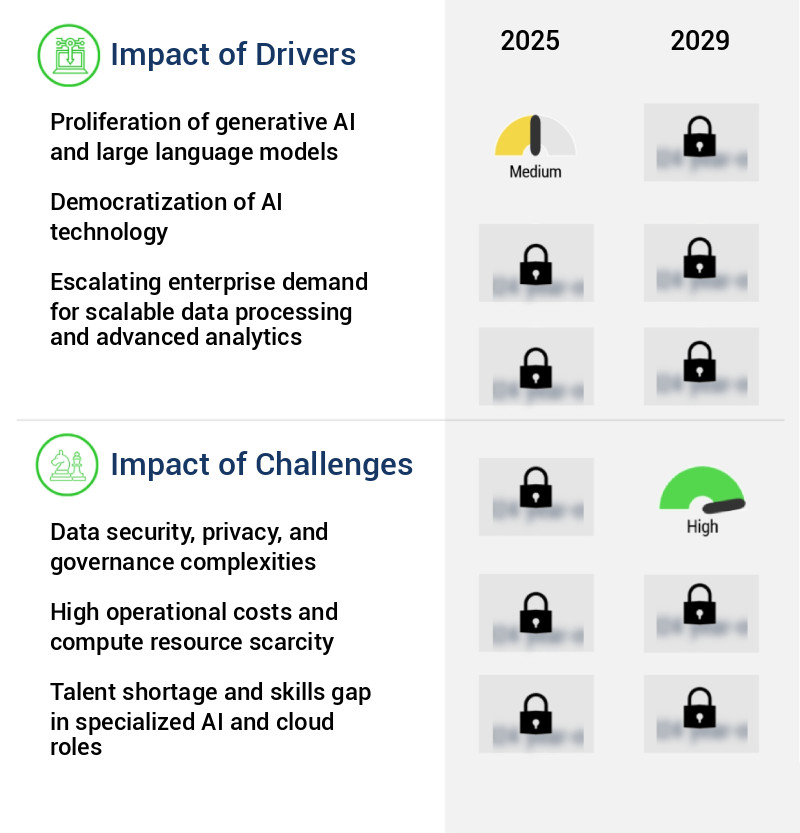
What are the key market drivers leading to the rise in the adoption of AI In Cloud Computing Industry?
- The proliferation of generative AI and large language models serves as the primary catalyst for market growth.
- The market is experiencing significant growth due to the increasing adoption of generative artificial intelligence and large language models. These advanced models, which can generate text, images, code, and other data, necessitate extensive computational resources for both training and inference. The sheer scale of the hardware and infrastructure required to develop and operate these models makes on-premises deployment impractical for most organizations. Cloud computing platforms, such as Microsoft Azure, Amazon Web Services, and Google Cloud Platform, offer access to vast fleets of specialized accelerators, including GPUs and TPUs, on a scalable, pay-as-you-go basis. This accessibility and flexibility have made cloud computing the default environment for generative AI.
- The market's size and potential are substantial, with estimates suggesting that The market is expected to reach a significant market share in the coming years. Organizations across various sectors, including healthcare, finance, and manufacturing, are increasingly leveraging AI in cloud computing to optimize processes, improve efficiency, and gain a competitive edge.
What are the market trends shaping the AI In Cloud Computing Industry?
- The rise of sovereign AI clouds and the establishment of national AI factories represent the emerging market trend in artificial intelligence technology.
- Artificial Intelligence (AI) in cloud computing is experiencing a significant evolution, with a growing trend towards sovereign AI clouds and national AI factories. This shift is influenced by increasing data privacy regulations, national security concerns, and the pursuit of digital and economic autonomy. Nations are recognizing AI as a valuable strategic asset and are taking proactive measures to establish domestic infrastructure, ensuring that sensitive data remains within their jurisdictional boundaries. This approach reduces dependence on foreign hyperscale cloud providers, whose operations are subject to their home countries' laws, mitigating potential geopolitical and data access risks. These developments underscore the importance of AI in cloud computing and the strategic significance of domestic infrastructure in the digital age.
What challenges does the AI In Cloud Computing Industry face during its growth?
- The intricate complexities surrounding data security, privacy, and governance pose a significant challenge to the growth of the industry.
- The market is experiencing a surge in adoption across various sectors due to its potential to enhance efficiency and productivity. According to recent estimates, the market is expected to grow significantly, with AI in cloud computing services projected to reach a value of over 120 billion U.S. Dollars by 2027, representing a substantial increase from the current market size. However, the market's evolving nature presents unique challenges, particularly in the realm of data security, privacy, and governance. Organizations are increasingly moving their proprietary and customer data to cloud environments to train sophisticated AI models, introducing significant perceived and actual risks.
- Data breaches, unauthorized access, and intellectual property theft are major concerns, compounded by a fragmented and evolving global regulatory landscape. Compliance with stringent data protection regulations such as the General Data Protection Regulation (GDPR) in Europe and various state-level laws in the United States necessitates meticulous data handling, residency, and processing protocols.
Exclusive Technavio Analysis on Customer Landscape
The ai in cloud computing market forecasting report includes the adoption lifecycle of the market, covering from the innovator's stage to the laggard's stage. It focuses on adoption rates in different regions based on penetration. Furthermore, the ai in cloud computing market report also includes key purchase criteria and drivers of price sensitivity to help companies evaluate and develop their market growth analysis strategies.
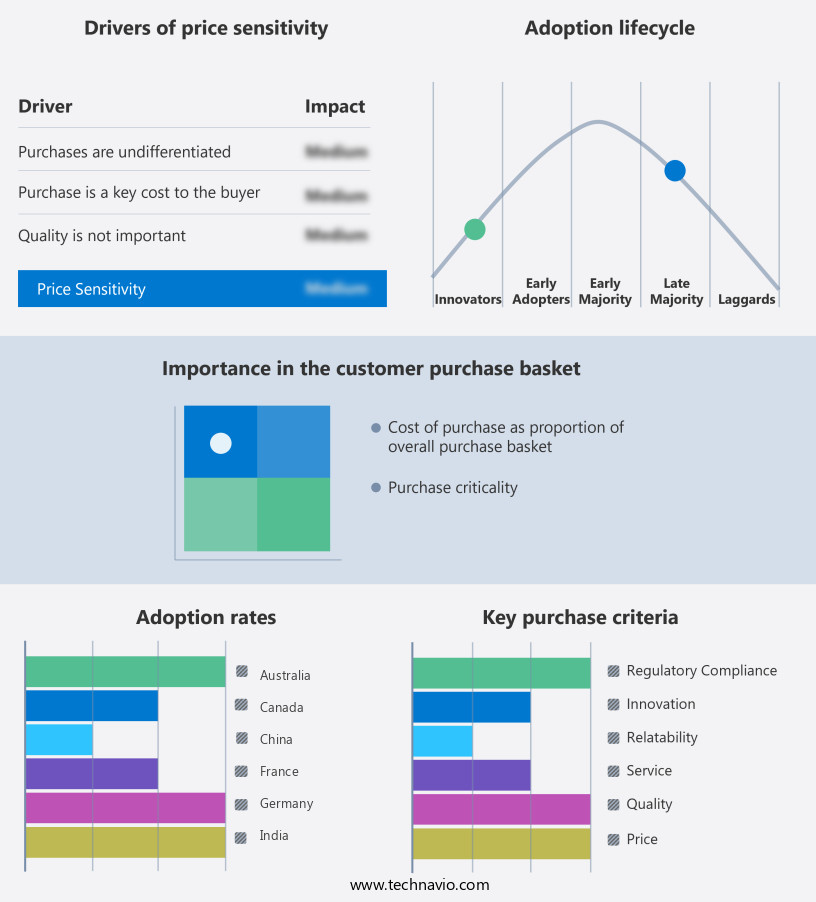
Customer Landscape of AI In Cloud Computing Industry
Competitive Landscape
Companies are implementing various strategies, such as strategic alliances, ai in cloud computing market forecast, partnerships, mergers and acquisitions, geographical expansion, and product/service launches, to enhance their presence in the industry.
Alibaba Cloud - The company specializes in artificial intelligence (AI) solutions within cloud computing, providing elastic computing for AI workloads and machine learning platforms like PAI. These offerings cater to various industries, including e-commerce, finance, and logistics, enhancing efficiency and productivity through AI-driven innovations.
The industry research and growth report includes detailed analyses of the competitive landscape of the market and information about key companies, including:
- Alibaba Cloud
- Amazon.com Inc.
- Broadcom Inc.
- Cloudera Inc.
- CoreWeave
- Databricks Inc.
- Dell Technologies Inc.
- DigitalOcean Holdings Inc.
- Equinix Inc.
- Google LLC
- Hewlett Packard Enterprise Co.
- Huawei Technologies Co. Ltd.
- Hugging Face
- International Business Machines Corp.
- Microsoft Corp.
- NVIDIA Corp.
- Oracle Corp.
- Pure Storage Inc.
- Salesforce Inc.
- SAP SE
- Snowflake Inc.
- Tencent Holdings Ltd.
Qualitative and quantitative analysis of companies has been conducted to help clients understand the wider business environment as well as the strengths and weaknesses of key industry players. Data is qualitatively analyzed to categorize companies as pure play, category-focused, industry-focused, and diversified; it is quantitatively analyzed to categorize companies as dominant, leading, strong, tentative, and weak.
Recent Development and News in AI In Cloud Computing Market
- In January 2024, Microsoft announced the general availability of Azure Cognitive Services' new language understanding model, "Davinci," which significantly improved text understanding capabilities in AI applications running on Microsoft's cloud platform (Microsoft Press Release).
- In March 2024, IBM and Google Cloud formed a strategic partnership to offer joint AI solutions, integrating IBM's Watson AI capabilities with Google Cloud Platform. This collaboration aimed to provide businesses with enhanced AI services and tools (IBM Press Release).
- In April 2024, Amazon Web Services (AWS) launched Amazon SageMaker Studio, a free, open-source, integrated development environment (IDE) for machine learning, making it easier for developers to build, train, and deploy machine learning models on AWS (AWS Press Release).
- In May 2025, NVIDIA, a leading technology company, announced a USD400 million investment in its Hopper AI supercomputer project, aiming to build the world's most advanced AI supercomputer, which will be deployed on Google Cloud Platform (NVIDIA Press Release).
Dive into Technavio's robust research methodology, blending expert interviews, extensive data synthesis, and validated models for unparalleled AI In Cloud Computing Market insights. See full methodology.
|
Market Scope
|
|
Report Coverage
|
Details
|
|
Page number
|
242
|
|
Base year
|
2024
|
|
Historic period
|
2019-2023 |
|
Forecast period
|
2025-2029
|
|
Growth momentum & CAGR
|
Accelerate at a CAGR of 36.3%
|
|
Market growth 2025-2029
|
USD 27429 million
|
|
Market structure
|
Fragmented
|
|
YoY growth 2024-2025(%)
|
29.1
|
|
Key countries
|
US, China, Japan, Germany, India, UK, South Korea, France, Canada, and Australia
|
|
Competitive landscape
|
Leading Companies, Market Positioning of Companies, Competitive Strategies, and Industry Risks
|
Request Free Sample
Research Analyst Overview
- The market continues to evolve, with new technologies and applications emerging at an unprecedented pace. Scalable AI architectures, such as containerized applications and serverless deployment, enable businesses to handle large-scale AI workloads with ease. Edge AI deployment, which brings AI processing closer to the data source, is gaining traction in industries like manufacturing and healthcare for real-time decision-making. Hyperparameter tuning and GPU-accelerated computing are essential components of AI model training pipelines, ensuring optimal performance and reducing training times. Generative AI models and computer vision algorithms are revolutionizing industries like media and entertainment, while natural language processing powers customer service and marketing automation.
- Deep learning frameworks and AI bias mitigation techniques are essential for building accurate and fair models. Model version control and model training pipelines ensure that businesses can manage and update their models effectively. Data security measures are increasingly important as AI models process sensitive information, with encryption and access controls becoming standard practices. Cloud AI models and AI explainability techniques enable businesses to gain insights from their data and make informed decisions. AI-driven automation and predictive maintenance models are transforming operations in industries like manufacturing and logistics. Reinforcement learning algorithms and federated learning platforms are pushing the boundaries of AI innovation.
- According to recent estimates, the global AI market is expected to grow by over 20% annually, driven by the increasing adoption of AI in various sectors. For instance, a leading retailer reported a 15% increase in sales through AI-driven product recommendations. These trends underscore the continuous dynamism and unfolding patterns in the market.
What are the Key Data Covered in this AI In Cloud Computing Market Research and Growth Report?
-
What is the expected growth of the AI In Cloud Computing Market between 2025 and 2029?
-
What segmentation does the market report cover?
-
The report is segmented by Component (Solutions and Services), Technology (Machine learning (ML), Deep learning, Natural language processing (NLP), and Others), End-user (BFSI, IT and telecommunications, Healthcare, Retail and consumer goods, and Others), and Geography (North America, APAC, Europe, Middle East and Africa, and South America)
-
Which regions are analyzed in the report?
-
North America, APAC, Europe, Middle East and Africa, and South America
-
What are the key growth drivers and market challenges?
-
Proliferation of generative AI and large language models, Data security, privacy, and governance complexities
-
Who are the major players in the AI In Cloud Computing Market?
-
Alibaba Cloud, Amazon.com Inc., Broadcom Inc., Cloudera Inc., CoreWeave, Databricks Inc., Dell Technologies Inc., DigitalOcean Holdings Inc., Equinix Inc., Google LLC, Hewlett Packard Enterprise Co., Huawei Technologies Co. Ltd., Hugging Face, International Business Machines Corp., Microsoft Corp., NVIDIA Corp., Oracle Corp., Pure Storage Inc., Salesforce Inc., SAP SE, Snowflake Inc., and Tencent Holdings Ltd.
Market Research Insights
- The market for AI in cloud computing is a dynamic and ever-evolving landscape. Two significant statistics illustrate its continuous growth. First, AI model deployments in the cloud have increased by 50% year-over-year. Second, industry experts anticipate a compound annual growth rate of 25% for AI in cloud computing services. Compute resource allocation and model monitoring tools are essential components of AI in cloud computing. For instance, a leading organization experienced a 30% increase in sales following the optimization of their compute resources. Additionally, AI infrastructure design plays a crucial role in addressing scalability challenges and ensuring regulatory compliance.
- Data lake architecture, PyTorch integrations, and model performance metrics are other essential elements of AI in cloud computing. TensorFlow deployments and privacy-preserving AI techniques contribute to model accuracy improvements and ethical considerations. Furthermore, cost optimization strategies, deployment automation, and AI development platforms are integral to operational excellence and the AI model lifecycle. In this market, model retraining, resource management tools, and model interpretability are essential for maintaining model accuracy and addressing inference latency concerns. Regulatory compliance AI, on-premise AI solutions, and multi-cloud AI strategies are crucial considerations for organizations navigating the complexities of AI implementation. Performance benchmarking and AI security protocols are also vital aspects of this market.
We can help! Our analysts can customize this ai in cloud computing market research report to meet your requirements.
Get in touch
1 Executive Summary
- 1.1 Market overview
- Executive Summary - Chart on Market Overview
- Executive Summary - Data Table on Market Overview
- Executive Summary - Chart on Global Market Characteristics
- Executive Summary - Chart on Market by Geography
- Executive Summary - Chart on Market Segmentation by Component
- Executive Summary - Chart on Market Segmentation by Technology
- Executive Summary - Chart on Market Segmentation by End-user
- Executive Summary - Chart on Incremental Growth
- Executive Summary - Data Table on Incremental Growth
- Executive Summary - Chart on Company Market Positioning
2 Technavio Analysis
- 2.1 Analysis of price sensitivity, lifecycle, customer purchase basket, adoption rates, and purchase criteria
- Analysis of price sensitivity, lifecycle, customer purchase basket, adoption rates, and purchase criteria
- 2.2 Criticality of inputs and Factors of differentiation
- Overview on criticality of inputs and factors of differentiation
- 2.3 Factors of disruption
- Overview on factors of disruption
- 2.4 Impact of drivers and challenges
- Impact of drivers and challenges in 2024 and 2029
3 Market Landscape
- 3.1 Market ecosystem
- Parent Market
- Data Table on - Parent Market
- 3.2 Market characteristics
- Market characteristics analysis
4 Market Sizing
- 4.1 Market definition
- Offerings of companies included in the market definition
- 4.2 Market segment analysis
- 4.4 Market outlook: Forecast for 2024-2029
- Chart on Global - Market size and forecast 2024-2029 ($ million)
- Data Table on Global - Market size and forecast 2024-2029 ($ million)
- Chart on Global Market: Year-over-year growth 2024-2029 (%)
- Data Table on Global Market: Year-over-year growth 2024-2029 (%)
5 Historic Market Size
- 5.1 Global AI In Cloud Computing Market 2019 - 2023
- Historic Market Size - Data Table on Global AI In Cloud Computing Market 2019 - 2023 ($ million)
- 5.2 Component segment analysis 2019 - 2023
- Historic Market Size - Component Segment 2019 - 2023 ($ million)
- 5.3 Technology segment analysis 2019 - 2023
- Historic Market Size - Technology Segment 2019 - 2023 ($ million)
- 5.4 End-user segment analysis 2019 - 2023
- Historic Market Size - End-user Segment 2019 - 2023 ($ million)
- 5.5 Geography segment analysis 2019 - 2023
- Historic Market Size - Geography Segment 2019 - 2023 ($ million)
- 5.6 Country segment analysis 2019 - 2023
- Historic Market Size - Country Segment 2019 - 2023 ($ million)
6 Five Forces Analysis
- 6.1 Five forces summary
- Five forces analysis - Comparison between 2024 and 2029
- 6.2 Bargaining power of buyers
- Bargaining power of buyers - Impact of key factors 2024 and 2029
- 6.3 Bargaining power of suppliers
- Bargaining power of suppliers - Impact of key factors in 2024 and 2029
- 6.4 Threat of new entrants
- Threat of new entrants - Impact of key factors in 2024 and 2029
- 6.5 Threat of substitutes
- Threat of substitutes - Impact of key factors in 2024 and 2029
- 6.6 Threat of rivalry
- Threat of rivalry - Impact of key factors in 2024 and 2029
- 6.7 Market condition
- Chart on Market condition - Five forces 2024 and 2029
7 Market Segmentation by Component
- 7.1 Market segments
- Chart on Component - Market share 2024-2029 (%)
- Data Table on Component - Market share 2024-2029 (%)
- 7.2 Comparison by Component
- Chart on Comparison by Component
- Data Table on Comparison by Component
- 7.3 Solutions - Market size and forecast 2024-2029
- Chart on Solutions - Market size and forecast 2024-2029 ($ million)
- Data Table on Solutions - Market size and forecast 2024-2029 ($ million)
- Chart on Solutions - Year-over-year growth 2024-2029 (%)
- Data Table on Solutions - Year-over-year growth 2024-2029 (%)
- 7.4 Services - Market size and forecast 2024-2029
- Chart on Services - Market size and forecast 2024-2029 ($ million)
- Data Table on Services - Market size and forecast 2024-2029 ($ million)
- Chart on Services - Year-over-year growth 2024-2029 (%)
- Data Table on Services - Year-over-year growth 2024-2029 (%)
- 7.5 Market opportunity by Component
- Market opportunity by Component ($ million)
- Data Table on Market opportunity by Component ($ million)
8 Market Segmentation by Technology
- 8.1 Market segments
- Chart on Technology - Market share 2024-2029 (%)
- Data Table on Technology - Market share 2024-2029 (%)
- 8.2 Comparison by Technology
- Chart on Comparison by Technology
- Data Table on Comparison by Technology
- 8.3 Machine learning (ML) - Market size and forecast 2024-2029
- Chart on Machine learning (ML) - Market size and forecast 2024-2029 ($ million)
- Data Table on Machine learning (ML) - Market size and forecast 2024-2029 ($ million)
- Chart on Machine learning (ML) - Year-over-year growth 2024-2029 (%)
- Data Table on Machine learning (ML) - Year-over-year growth 2024-2029 (%)
- 8.4 Deep learning - Market size and forecast 2024-2029
- Chart on Deep learning - Market size and forecast 2024-2029 ($ million)
- Data Table on Deep learning - Market size and forecast 2024-2029 ($ million)
- Chart on Deep learning - Year-over-year growth 2024-2029 (%)
- Data Table on Deep learning - Year-over-year growth 2024-2029 (%)
- 8.5 Natural language processing (NLP) - Market size and forecast 2024-2029
- Chart on Natural language processing (NLP) - Market size and forecast 2024-2029 ($ million)
- Data Table on Natural language processing (NLP) - Market size and forecast 2024-2029 ($ million)
- Chart on Natural language processing (NLP) - Year-over-year growth 2024-2029 (%)
- Data Table on Natural language processing (NLP) - Year-over-year growth 2024-2029 (%)
- 8.6 Others - Market size and forecast 2024-2029
- Chart on Others - Market size and forecast 2024-2029 ($ million)
- Data Table on Others - Market size and forecast 2024-2029 ($ million)
- Chart on Others - Year-over-year growth 2024-2029 (%)
- Data Table on Others - Year-over-year growth 2024-2029 (%)
- 8.7 Market opportunity by Technology
- Market opportunity by Technology ($ million)
- Data Table on Market opportunity by Technology ($ million)
9 Market Segmentation by End-user
- 9.1 Market segments
- Chart on End-user - Market share 2024-2029 (%)
- Data Table on End-user - Market share 2024-2029 (%)
- 9.2 Comparison by End-user
- Chart on Comparison by End-user
- Data Table on Comparison by End-user
- 9.3 BFSI - Market size and forecast 2024-2029
- Chart on BFSI - Market size and forecast 2024-2029 ($ million)
- Data Table on BFSI - Market size and forecast 2024-2029 ($ million)
- Chart on BFSI - Year-over-year growth 2024-2029 (%)
- Data Table on BFSI - Year-over-year growth 2024-2029 (%)
- 9.4 IT and telecommunications - Market size and forecast 2024-2029
- Chart on IT and telecommunications - Market size and forecast 2024-2029 ($ million)
- Data Table on IT and telecommunications - Market size and forecast 2024-2029 ($ million)
- Chart on IT and telecommunications - Year-over-year growth 2024-2029 (%)
- Data Table on IT and telecommunications - Year-over-year growth 2024-2029 (%)
- 9.5 Healthcare - Market size and forecast 2024-2029
- Chart on Healthcare - Market size and forecast 2024-2029 ($ million)
- Data Table on Healthcare - Market size and forecast 2024-2029 ($ million)
- Chart on Healthcare - Year-over-year growth 2024-2029 (%)
- Data Table on Healthcare - Year-over-year growth 2024-2029 (%)
- 9.6 Retail and consumer goods - Market size and forecast 2024-2029
- Chart on Retail and consumer goods - Market size and forecast 2024-2029 ($ million)
- Data Table on Retail and consumer goods - Market size and forecast 2024-2029 ($ million)
- Chart on Retail and consumer goods - Year-over-year growth 2024-2029 (%)
- Data Table on Retail and consumer goods - Year-over-year growth 2024-2029 (%)
- 9.7 Others - Market size and forecast 2024-2029
- Chart on Others - Market size and forecast 2024-2029 ($ million)
- Data Table on Others - Market size and forecast 2024-2029 ($ million)
- Chart on Others - Year-over-year growth 2024-2029 (%)
- Data Table on Others - Year-over-year growth 2024-2029 (%)
- 9.8 Market opportunity by End-user
- Market opportunity by End-user ($ million)
- Data Table on Market opportunity by End-user ($ million)
10 Customer Landscape
- 10.1 Customer landscape overview
- Analysis of price sensitivity, lifecycle, customer purchase basket, adoption rates, and purchase criteria
11 Geographic Landscape
- 11.1 Geographic segmentation
- Chart on Market share by geography 2024-2029 (%)
- Data Table on Market share by geography 2024-2029 (%)
- 11.2 Geographic comparison
- Chart on Geographic comparison
- Data Table on Geographic comparison
- 11.3 North America - Market size and forecast 2024-2029
- Chart on North America - Market size and forecast 2024-2029 ($ million)
- Data Table on North America - Market size and forecast 2024-2029 ($ million)
- Chart on North America - Year-over-year growth 2024-2029 (%)
- Data Table on North America - Year-over-year growth 2024-2029 (%)
- 11.4 APAC - Market size and forecast 2024-2029
- Chart on APAC - Market size and forecast 2024-2029 ($ million)
- Data Table on APAC - Market size and forecast 2024-2029 ($ million)
- Chart on APAC - Year-over-year growth 2024-2029 (%)
- Data Table on APAC - Year-over-year growth 2024-2029 (%)
- 11.5 Europe - Market size and forecast 2024-2029
- Chart on Europe - Market size and forecast 2024-2029 ($ million)
- Data Table on Europe - Market size and forecast 2024-2029 ($ million)
- Chart on Europe - Year-over-year growth 2024-2029 (%)
- Data Table on Europe - Year-over-year growth 2024-2029 (%)
- 11.6 Middle East and Africa - Market size and forecast 2024-2029
- Chart on Middle East and Africa - Market size and forecast 2024-2029 ($ million)
- Data Table on Middle East and Africa - Market size and forecast 2024-2029 ($ million)
- Chart on Middle East and Africa - Year-over-year growth 2024-2029 (%)
- Data Table on Middle East and Africa - Year-over-year growth 2024-2029 (%)
- 11.7 South America - Market size and forecast 2024-2029
- Chart on South America - Market size and forecast 2024-2029 ($ million)
- Data Table on South America - Market size and forecast 2024-2029 ($ million)
- Chart on South America - Year-over-year growth 2024-2029 (%)
- Data Table on South America - Year-over-year growth 2024-2029 (%)
- 11.8 US - Market size and forecast 2024-2029
- Chart on US - Market size and forecast 2024-2029 ($ million)
- Data Table on US - Market size and forecast 2024-2029 ($ million)
- Chart on US - Year-over-year growth 2024-2029 (%)
- Data Table on US - Year-over-year growth 2024-2029 (%)
- 11.9 China - Market size and forecast 2024-2029
- Chart on China - Market size and forecast 2024-2029 ($ million)
- Data Table on China - Market size and forecast 2024-2029 ($ million)
- Chart on China - Year-over-year growth 2024-2029 (%)
- Data Table on China - Year-over-year growth 2024-2029 (%)
- 11.10 Japan - Market size and forecast 2024-2029
- Chart on Japan - Market size and forecast 2024-2029 ($ million)
- Data Table on Japan - Market size and forecast 2024-2029 ($ million)
- Chart on Japan - Year-over-year growth 2024-2029 (%)
- Data Table on Japan - Year-over-year growth 2024-2029 (%)
- 11.11 Germany - Market size and forecast 2024-2029
- Chart on Germany - Market size and forecast 2024-2029 ($ million)
- Data Table on Germany - Market size and forecast 2024-2029 ($ million)
- Chart on Germany - Year-over-year growth 2024-2029 (%)
- Data Table on Germany - Year-over-year growth 2024-2029 (%)
- 11.12 India - Market size and forecast 2024-2029
- Chart on India - Market size and forecast 2024-2029 ($ million)
- Data Table on India - Market size and forecast 2024-2029 ($ million)
- Chart on India - Year-over-year growth 2024-2029 (%)
- Data Table on India - Year-over-year growth 2024-2029 (%)
- 11.13 UK - Market size and forecast 2024-2029
- Chart on UK - Market size and forecast 2024-2029 ($ million)
- Data Table on UK - Market size and forecast 2024-2029 ($ million)
- Chart on UK - Year-over-year growth 2024-2029 (%)
- Data Table on UK - Year-over-year growth 2024-2029 (%)
- 11.14 South Korea - Market size and forecast 2024-2029
- Chart on South Korea - Market size and forecast 2024-2029 ($ million)
- Data Table on South Korea - Market size and forecast 2024-2029 ($ million)
- Chart on South Korea - Year-over-year growth 2024-2029 (%)
- Data Table on South Korea - Year-over-year growth 2024-2029 (%)
- 11.15 France - Market size and forecast 2024-2029
- Chart on France - Market size and forecast 2024-2029 ($ million)
- Data Table on France - Market size and forecast 2024-2029 ($ million)
- Chart on France - Year-over-year growth 2024-2029 (%)
- Data Table on France - Year-over-year growth 2024-2029 (%)
- 11.16 Canada - Market size and forecast 2024-2029
- Chart on Canada - Market size and forecast 2024-2029 ($ million)
- Data Table on Canada - Market size and forecast 2024-2029 ($ million)
- Chart on Canada - Year-over-year growth 2024-2029 (%)
- Data Table on Canada - Year-over-year growth 2024-2029 (%)
- 11.17 Australia - Market size and forecast 2024-2029
- Chart on Australia - Market size and forecast 2024-2029 ($ million)
- Data Table on Australia - Market size and forecast 2024-2029 ($ million)
- Chart on Australia - Year-over-year growth 2024-2029 (%)
- Data Table on Australia - Year-over-year growth 2024-2029 (%)
- 11.18 Market opportunity by geography
- Market opportunity by geography ($ million)
- Data Tables on Market opportunity by geography ($ million)
12 Drivers, Challenges, and Opportunity/Restraints
- 12.3 Impact of drivers and challenges
- Impact of drivers and challenges in 2024 and 2029
- 12.4 Market opportunities/restraints
13 Competitive Landscape
- 13.2 Competitive Landscape
- Overview on criticality of inputs and factors of differentiation
- 13.3 Landscape disruption
- Overview on factors of disruption
- 13.4 Industry risks
- Impact of key risks on business
14 Competitive Analysis
- 14.2 Company ranking index
- 14.3 Market positioning of companies
- Matrix on companies position and classification
- 14.4 Alibaba Cloud
- Alibaba Cloud - Overview
- Alibaba Cloud - Product / Service
- Alibaba Cloud - Key offerings
- SWOT
- 14.5 Amazon.com Inc.
- Amazon.com Inc. - Overview
- Amazon.com Inc. - Business segments
- Amazon.com Inc. - Key news
- Amazon.com Inc. - Key offerings
- Amazon.com Inc. - Segment focus
- SWOT
- 14.6 Broadcom Inc.
- Broadcom Inc. - Overview
- Broadcom Inc. - Business segments
- Broadcom Inc. - Key news
- Broadcom Inc. - Key offerings
- Broadcom Inc. - Segment focus
- SWOT
- 14.7 CoreWeave
- CoreWeave - Overview
- CoreWeave - Product / Service
- CoreWeave - Key offerings
- SWOT
- 14.8 Databricks Inc.
- Databricks Inc. - Overview
- Databricks Inc. - Product / Service
- Databricks Inc. - Key offerings
- SWOT
- 14.9 Google LLC
- Google LLC - Overview
- Google LLC - Product / Service
- Google LLC - Key offerings
- SWOT
- 14.10 Huawei Technologies Co. Ltd.
- Huawei Technologies Co. Ltd. - Overview
- Huawei Technologies Co. Ltd. - Product / Service
- Huawei Technologies Co. Ltd. - Key news
- Huawei Technologies Co. Ltd. - Key offerings
- SWOT
- 14.11 International Business Machines Corp.
- International Business Machines Corp. - Overview
- International Business Machines Corp. - Business segments
- International Business Machines Corp. - Key news
- International Business Machines Corp. - Key offerings
- International Business Machines Corp. - Segment focus
- SWOT
- 14.12 Microsoft Corp.
- Microsoft Corp. - Overview
- Microsoft Corp. - Business segments
- Microsoft Corp. - Key news
- Microsoft Corp. - Key offerings
- Microsoft Corp. - Segment focus
- SWOT
- 14.13 NVIDIA Corp.
- NVIDIA Corp. - Overview
- NVIDIA Corp. - Business segments
- NVIDIA Corp. - Key news
- NVIDIA Corp. - Key offerings
- NVIDIA Corp. - Segment focus
- SWOT
- 14.14 Oracle Corp.
- Oracle Corp. - Overview
- Oracle Corp. - Business segments
- Oracle Corp. - Key news
- Oracle Corp. - Key offerings
- Oracle Corp. - Segment focus
- SWOT
- 14.15 Salesforce Inc.
- Salesforce Inc. - Overview
- Salesforce Inc. - Product / Service
- Salesforce Inc. - Key news
- Salesforce Inc. - Key offerings
- SWOT
- 14.16 SAP SE
- SAP SE - Overview
- SAP SE - Business segments
- SAP SE - Key news
- SAP SE - Key offerings
- SAP SE - Segment focus
- SWOT
- 14.17 Snowflake Inc.
- Snowflake Inc. - Overview
- Snowflake Inc. - Product / Service
- Snowflake Inc. - Key offerings
- SWOT
- 14.18 Tencent Holdings Ltd.
- Tencent Holdings Ltd. - Overview
- Tencent Holdings Ltd. - Product / Service
- Tencent Holdings Ltd. - Key offerings
- SWOT
15 Appendix
- 15.2 Inclusions and exclusions checklist
- Inclusions checklist
- Exclusions checklist
- 15.3 Currency conversion rates for US$
- Currency conversion rates for US$
- 15.4 Research methodology
- 15.7 Validation techniques employed for market sizing
- Validation techniques employed for market sizing
- 15.9 360 degree market analysis
- 360 degree market analysis
- 15.10 List of abbreviations







![]() Get the report (PDF) sent to your email within minutes.
Get the report (PDF) sent to your email within minutes.
Complimentary full Excel data with your report purchase.